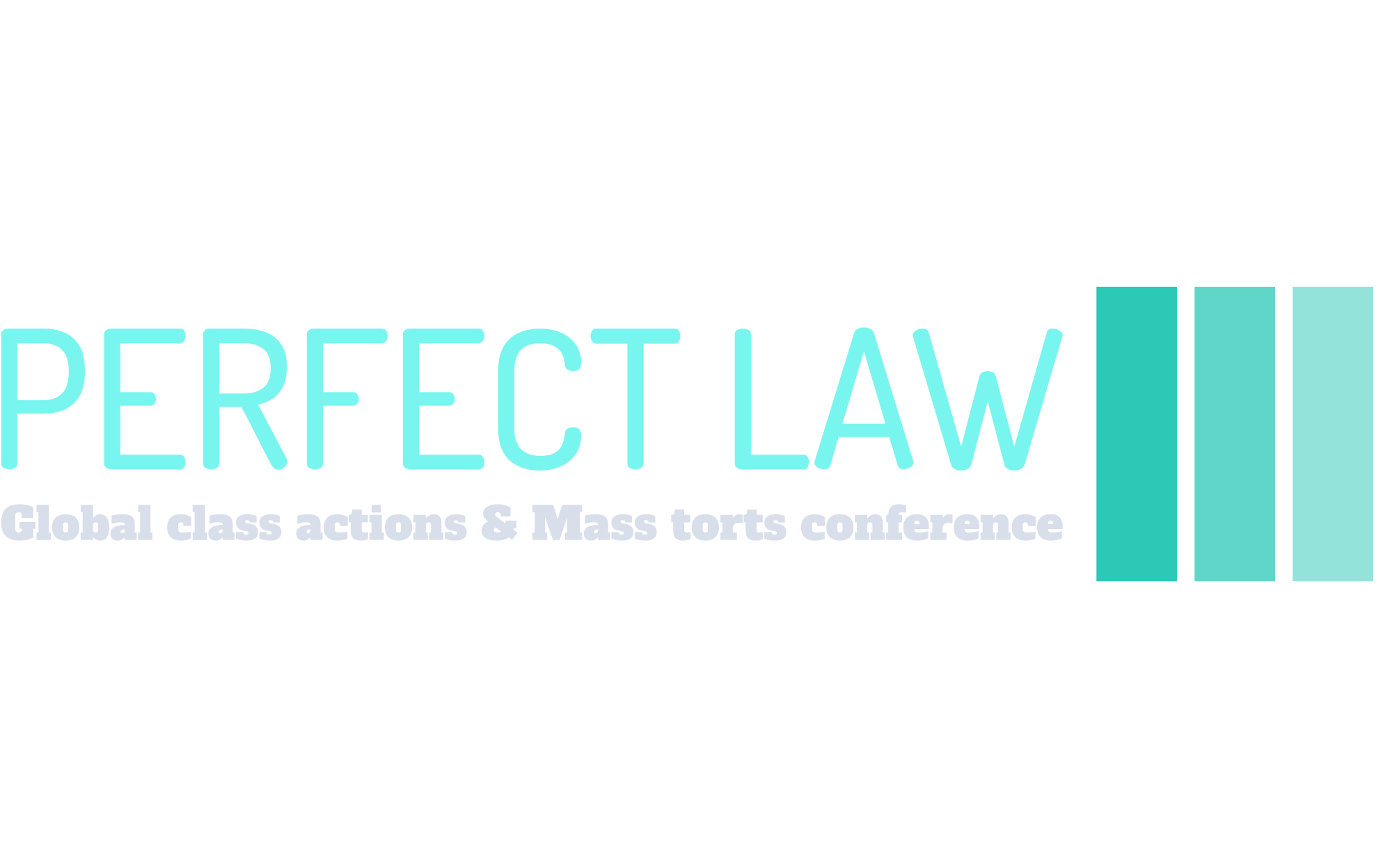Day 2: Session A – Class and Mass Tort Actions in Specific Subject Areas
Day two of the conference was split into two parallel sessions, the first of which focused on class actions in specific subject areas. That session was opened by the welcome from the conference board members Scott Hardy of Top Class Actions and Guy Robson of Pogust Goodhead, who emphasized the fact that class actions can potentially touch upon and protect ordinary people in many aspects of their lives.
The first panel on privacy and data breach was chaired by John Yanchunis of the Morgan & Morgan Complex Litigation Group. The discussion was kicked off with the question of how cyber experts and lawyers work together in data breach cases. Douglas Meal of Orrick emphasized that these cases distinguish themselves from others because they are triggered by a third-party crime. To solve the crime, external forensic advice from data experts is indispensable. Mary Frantz of CyberNINES defined the goal of the data expert as helping the company recover from the data breach and get back to operations while containing the incident. Data experts work closely with lawyers and rely upon the legal counsel’s advice as to what the scope of the investigation should be since this can be vital for legal proceedings. Marco Scialdone of Euroconsumers highlighted the difficulties in starting class actions in data protection cases, which among other things stem from the fact that the quantification of harm is difficult. In addition, he argued that, according to his reading of recent ECJ case law, the standard of care of the data collector should encompass the duty to take all necessary data protection measures to prevent data breaches. John Yanchunis concluded the session by stressing the importance of discussing cybercrime and the need to further take protective action. Cybercrime is expected to cost the world 8 trillion dollars in 2023.
Ingrid Gubbay of Hausfeld chaired the second panel, which dealt with ESG claims. After briefly reviewing the history of ESG claims, Ingrid Gubbay asserted that over time more attention has been devoted to the E-pillar of ESG claims with a particular focus on sustainability. Martina de Lind van Wijngaarden of Freshfields Bruckhaus Deringer emphasized the dramatic change in climate change litigation in the last five to six years, which is mainly taking place in three forms: NGOs vs the state to oblige the latter to take action to protect citizens, NGOs vs companies to change the strategic course of the company, and individuals against companies for the sake of compensation. She expects many more cases to come, which was endorsed by Hunter Shkolnik of Napoli Shkolnik. He stated that although the class action wave of ESG claims is not yet of substantial size in the US, it is growing and will likely become one of the major trends in the near future. These types of claims are highly dependent, however, on the political decisions made by the different states, which can encourage or discourage the pursuit of ESG goals through courts. Esther Berezofsky of Motley Rice added that the degree of litigation vigor will vary by country and will be influenced by the respective litigation culture.
The third panel, chaired by Miguel Sousa Ferro of Milberg, dove into the realm of competition and discussed topics ranging from price fixing, excessive pricing, and anti-competitive agreements, to unlawful practices. Barbara Mahoney of HB Sweden AB elaborated on how price umbrellas were tackled in the US and Canada and explained that, in class actions, it can be harder to demonstrate the damages than in an individual case. Defining the class requires extraordinary precision, whereby claims that have a non-cartel component need to be eliminated. Oliver Latham of Charles River Associates stressed that the challenge in these class actions often does not lie with the substantive claim, but rather with showing a viable methodology in quantifying the damages. Damage quantification has become of pivotal importance after the CAT’s decision in Gormsen v Meta. There is a need for the methodology to reflect the industry under scrutiny, which means that in certain cases alternatives for econometrics will need to be considered. One option would be relying on documented business practices, such as cost-plus-pricing approaches, that can help determine the overcharge. With respect to enforcement, it was argued that currently there is still private underenforcement, but this tendency is set to change over time. In the US, fewer cartel cases have been dealt with recently, which has led to less overall enforcement. The panel concluded by addressing the issue of causality in the legal and economic context. Although the definitions are subject to debate in theory, the application of the concept seems to work in practice.
Panel four explored competition class actions that follow the abuse of a dominant position. The panel began the discussion with the acknowledgment that “market share is king” when assessing whether a company has a dominant position. However, the assessment is inherently economic because it is often contested what the “market” is of which the company has a share. In addition, beyond market shares, the assessment often requires innovative methodologies and is becoming more challenging with the development of new markets, such as two-sided platforms. In this respect, the EU Digital Markets Act is expected to lead to numerous changes and litigation across Europe. Nils von Hinten-Reed of CEG Europe, chairing the panel, stressed the large-scale activity that is starting to take place in private enforcement, which seems to be much faster than public enforcement, thereby leading to “significant changes on the ground.” Alex Petrasincu of Hausfeld brought the German perspective into the picture and explained that Germany differs from the rest of Europe concerning its application of the concept of “relative dominance,” which is a standard below the usual threshold of dominance. He notably stated that under the current regime, getting collective actions and litigation funding off the ground in Germany is still challenging. Natasha Pearman of Milberg expects that in the UK there might come an expansion as to what can be considered an abuse and that there will be a larger focus on exploitative abuses. She added that with regard to the methodology, the CAT is willing to give plaintiffs a second chance rather than throwing them out of court right away, which eventually results in several available attempts to meet the standard. This less restrictive approach to certification has arguably made the certification test even more applicant-friendly in certain circumstances, but to the detriment of the efficient handling of cases. The panel agreed that the CAT’s stance on certification methodology should become clearer over time. Mark Sansom of Freshfields Bruckhaus Deringer opined that competition law should not be used as the panacea for all abuses for which specific legal regimes exist. Regulators are being cut out of policy developments by the direct referral to courts as a result of the desire to use competition law for all potential abuses.
The fifth panel focused on securities and investor claims from a global perspective. Guus Warringa of Grant & Eisenhofer opened the discussion by highlighting the difference between the roles of active and passive investors in starting security litigation. Carol Villegas of Labaton Sucharow explained that institutional investors are leading securities class action with higher recovery rates in comparison with retail investors. Guus Warringa argued that despite the difference, the type of investor should be irrelevant for the protection against misconduct by companies. Andrew Hill of Fox Williams explained that in the UK there is no proper class action regime for securities litigation. Nevertheless, he stressed that pressure is building up concerning climate litigation. The developments will be impacted by the legislative actions of the government. The role of governments is also acknowledged by Carol Villegas, who expects that, in the US, the red states will impede ESG litigation, whereas the blue states will facilitate it. Tim Finney of Phi Finney McDonald endorsed the view that class actions are an eminently political area of the law. Changes in the Australian government have significantly influenced the class action landscape, in particular with respect to the regulation of third-party funding, with the current Labor government taking a favorable stance.
The sixth panel, chaired by Guy Robson of Pogust Goodhead, discussed mass tort and group litigation claims. Gary Davies of Ankura explained that, in the UK’s mass tort and group litigation regimes, the claimant needs to pay the defendant’s costs if they lose the case and, because these costs can be substantial, the litigation dynamic is markedly different from other jurisdictions where adverse costs are usually not awarded, such as the US. Wesley Vader of Bureau Brandeis provided the Dutch perspective and explained that, although Dutch law imposes a loser-pays rule in principle, the costs awarded follow a set scale and typically cover only a fraction of the actual costs. In addition to the WAMCA regime, bundling of claims can be achieved by the assignment model as well as with several parties providing a power of attorney to a single lawyer. Nicholas DeLuca of Alvarez & Marsal added that apart from the costs, the long duration of group litigation is a problem, which further impedes the resolution of mass claims. Overall, the panel agreed that contingency fees might offer a solution to make group litigation more attractive, but that settlement times need to be significantly improved, which might be achieved with more mature legal frameworks.
The seventh panel, chaired by Harris Pogust of Pogust Goodhead, addressed product liability claims for medical devices and drug claims. Becca Timmons of Levin Papantonio Rafferty used the breast implant liability claims in the US to explain the role of multi-district litigation (MDL) in the US. The panelists agreed that referral fees between law firms work well to ensure that clients get the best representation. However, the aggregation of cases by bad aggregators can lead to the dilution of the pay to the aggrieved parties. Mark Lanier of Lanier, Longstaff, Hedar & Roberts underlined the important contribution of mass tort litigation by discussing the successful case against Johnson & Johnson concerning talcum powder products. Thanks to this litigation, thousands of women who developed ovarian cancer could be compensated for the damage that was inflicted on them. In contrast, Sylvie Gallage-Alwis of Signature Litigation emphasized the dangers of further facilitating mass claims and stressed that the current system that is in place in France can deal with a large number of cases. Harris Pogust sees great potential in getting the class action regime on track in the UK and Europe while drawing lessons from the US experience. The panelists agreed that, although Europe can learn from the experience in the US, it must be prevented that an identical system will develop in Europe. The panelists concluded by acknowledging the need to train judges to prepare them to handle effectively the specifics of mass tort litigation.
Anton Burri,[1] Johannes Nickl,[2] Adrianus van Heusden[3]
[1] Faculty of Law, University of Lucerne, Switzerland.
[2] Faculty of Law, Heidelberg University, Germany.
[3] Rotterdam Institute of Law and Economics, Erasmus University Rotterdam, The Netherlands.
Foto Credit: Philip Pankhurst



